Muscle Insider
New member
As a regular gymgoer, you probably know that protein is your best friend. Building muscle, recovering from hard training, and losing body fat require a pretty high protein intake. You may understandably assume that you have to eat plenty of meat and chicken to get there. But did you know you can get protein from vegetables, as well?...
The post Add These High-Protein Vegetables to Your Diet for a Muscle-Building Boost appeared first on BarBend.
As a regular gymgoer, you probably know that protein is your best friend. Building muscle, recovering from hard training, and losing body fat require a pretty high protein intake. You may understandably assume that you have to eat plenty of meat and chicken to get there. But did you know you can get protein from vegetables, as well?
High-protein vegetables are packed with health-boosting nutrients, and you can combine them into satisfying, tasty meals to help you reach your goals. Whether you want to build muscle on a vegan diet or just add more plant-based protein, we’ve got the goods.
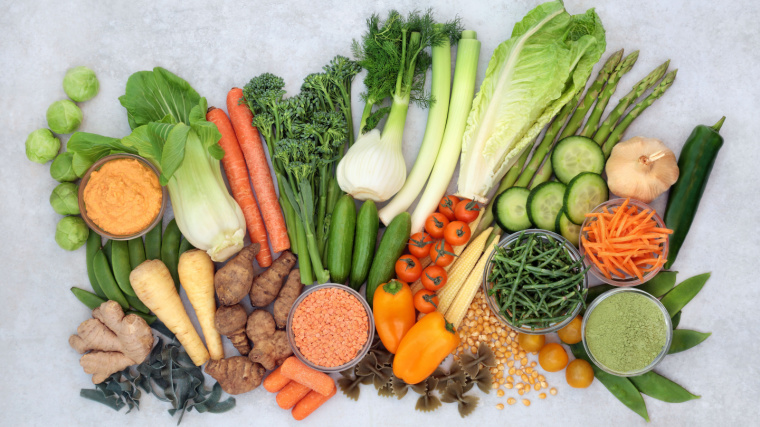 Credit: marilyn barbone / Shutterstock
Credit: marilyn barbone / Shutterstock
Here, you’ll learn explain the health benefits of protein and the most protein-rich veggies with all their nutritional information. We’ll also give you the details on calculating how much protein your body needs, depending on your goals. Healthy eating doesn’t have to be bland. So grab your shopping list and prepare to add these muscle-building veggies to your meal plan.
Editor’s Note: The content on BarBend is meant to be informative in nature, but it should not be taken as medical advice. When starting a new training regimen and/or diet, it is always a good idea to consult with a trusted medical professional. We are not a medical resource. The opinions and articles on this site are not intended for use as diagnosis, prevention, and/or treatment of health problems. They are not substitutes for consulting a qualified medical professional.
Why You Need Protein
All your food consists of three macronutrients: protein, carbohydrates, and fat. Macronutrients combine to influence your health and provide energy. (1)
You need all three to fuel your health and workouts, but we’re here for muscle hypertrophy. When it comes to training, you need protein to help you build muscle mass and lose body fat. Eating a healthy diet packed with protein also influences your heart and bone health while boosting your immune system. Let’s break it down.
Helps Build Muscle Mass
Strength athletes are so fond of protein for a reason. This macronutrient helps build muscle mass when paired with resistance training. Here’s how it works.
Twenty amino acids, often called building blocks, make up muscle protein. Eleven amino acids are non-essential, and the remaining nine are essential amino acids. Your body cannot make them on its own, so you need to get them through your diet as complete protein sources. All twenty amino acids are necessary for hypertrophy. (2)
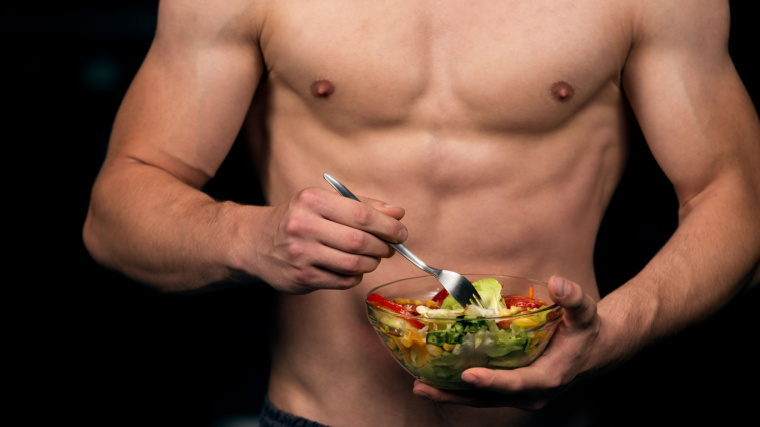 Credit: FS Stock / Shutterstock
Credit: FS Stock / Shutterstock
[Read More: The 12 Best Vegan Protein Powders]
When you’re in the gym lifting weights, you’re breaking down your muscle fibers. When you eat high-protein foods, you’re consuming dietary protein that helps repair and regenerate your muscle fibers after all those intense leg exercises on your favorite training day of the week. This process leads to muscle protein synthesis — or building muscle mass. (3)(4)
Resistance training is half of the equation, but your body needs protein to maximize your hard-earned gains.
Helps With Fat Loss
Whether you have a weight loss goal or you’re a bodybuilder on a weight cut, protein will help you with fat loss. Feeling full from your food can help you stay on track when you’re reducing your calories or portions. Protein is the most satiating macronutrient, so packing your meals with it can help you feel full between meals. (5)
Eating a high-protein diet also increases thermogenesis, meaning your body has to work harder to digest your food, slightly increasing your total daily energy expenditure (TDEE). Complete protein sources may have a higher thermic effect, increasing your TDEE even more. (5)(6)
[Read More: 20 High-Fiber Foods to Support Digestion]
Lastly, a high-protein diet and resistance training during weight loss can help your body preserve lean muscle mass. Some people can theoretically lose weight by reducing their calories or portions, but they may also lose muscle. Keeping your protein high and lifting weights is the key to maintaining muscle mass while losing body fat. (5)
Improves Heart Health
Athletes need a strong heart for tough HIIT workouts — AKA, high-intensity interval training sessions. Healthy eating and regular exercise are fundamental to strong cardiovascular health. Getting enough protein can help lower your risk of high blood pressure, high cholesterol, and heart disease. (7)
The sources of protein you choose matter, too. A 2020 meta-analysis examined the link between different types of protein and cardiovascular (CV) diseases. They found that plant-based protein may be associated with a lower risk of CV diseases. (8)
 Credit: eggeegg / Shutterstock
Credit: eggeegg / Shutterstock
[Read More: The 13 Best Protein Powder]
It doesn’t mean you have to give up all meat — but it’s all the more reason to add some of our high-protein vegetables to your diet.
Boosts Bone Health
What else does an athlete need beyond solid muscles and a healthy heart? Strong bones.
You may think of vitamin D and calcium as the nutrients associated with bone health, but protein is also essential. Research shows that protein enhances IGF-1, a growth hormone that influences bone development. In multiple clinical trials, low protein intake has been associated with low bone health. (9)
[Read More: 20 High-Protein, Low-Calorie Foods Worth Subbing Into Your Diet]
Consuming enough protein can also help prevent osteoporosis, a condition where you lose bone mass as you age. Older adults, especially cisgender women, are more likely to develop it. Osteoporosis can also increase your risk of fractures. (9)
Health professionals recommend getting plenty of protein, vitamin D, and calcium in your diet, along with resistance training and weight-bearing cardio workouts, to prevent osteoporosis.
Boosts Immune System
It has been well-established that eating a diet low in protein can weaken your immune system. The amino acids in protein directly impact your immune system — particularly arginine, glutamine, and cysteine. (10)
Consuming complete protein sources will give you all the amino acids your body needs to fight off illnesses. Eating protein-rich vegetables will also give you micronutrients and antioxidants, which can help strengthen your immune cells. (11)
Can You Get Adequate Protein From Vegetables?
Yes, you can reach your protein intake goals through high-protein vegetables alone. Plenty of vegetarian and vegan athletes build muscle through plant-based protein. Whether you’re looking to stop eating animal products or just want to add more plants to your diet, you’ll just need to make some adjustments.
Sure, getting 30 grams of protein through a single serving of chicken breast may be quicker than countless servings of spinach, but you can get creative. Combining multiple high-protein vegetables into stews or a stir-fry can increase the protein content of your plant-based dish.
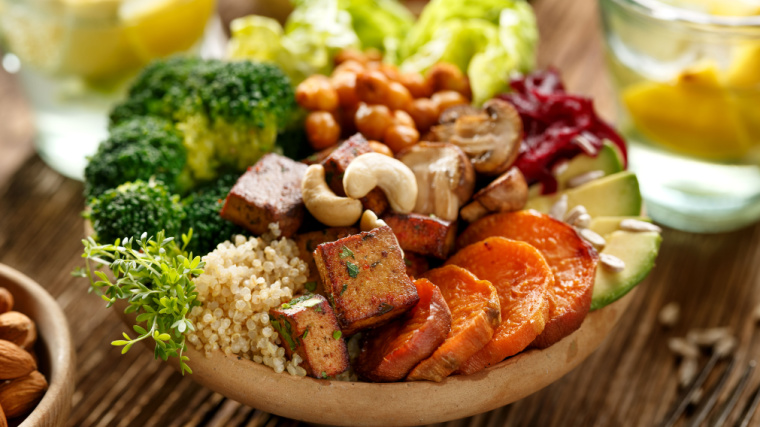 Credit: zi3000 / Shutterstock
Credit: zi3000 / Shutterstock
[Read More: The 12 Best Greens Powders]
Dietitians recommend getting the bulk of your nutrients through food sources, but you can add supplements if you struggle to get enough protein. Making shakes with a high-quality vegan protein powder can help you boost your intake. Soy protein powder is a great choice. It’s a complete protein source and contains all the essential amino acids you need to build muscle.
The Best High-Protein Vegetables
You may be used to having veggies as a side dish or salad, but they can also be the main event. Here are the best high-protein vegetables to boost your nutrient intake or support a vegan diet.
The nutritional information for these veggies comes from the FoodData Central feature on the United States Department of Agriculture (USDA) website. (12)
Edamame
Edamame beans are a type of soybean from the legumes family. Edamame is one of the most protein-rich vegetables you can eat. They also contain vitamin K and folate and are a great source of healthy carbs.
One cup of edamame contains 18.5 grams of protein, 12 grams of fat, and 13.8 grams of carbohydrates.
Lentils
Lentils are also from the legume family. Some consider them a superfood because they are so nutrient-dense. They contain B vitamins, magnesium, potassium, and phosphorus. They’re a great source of protein and also high in fiber.
One cup of lentils yields 17.9 grams of protein, 0.8 grams of fat, and 39.9 grams of carbs.
Black Beans
Black beans are versatile and a great addition to a stir-fry. They contain antioxidants to boost your immune system and fiber to keep you full.
A one-cup serving of black beans has 15 grams of protein, one gram of fat, and 41 grams of carbs.
Chickpeas
Chickpeas, or garbanzo beans, are a nutty legume and the main ingredient in hummus and falafel. Chickpeas contain fiber, protein, B vitamins, and folate.
One cup of chickpeas yields 14.5 grams of protein, four grams of fat, and 45 grams of carbs.
Mung Beans
Mung beans are another superfood to add to your diet. They’re high in all of the essential amino acids that you need to build muscle. Mung beans also contain potassium, magnesium, phosphorus, and other antioxidants that may help lower blood pressure and cholesterol.
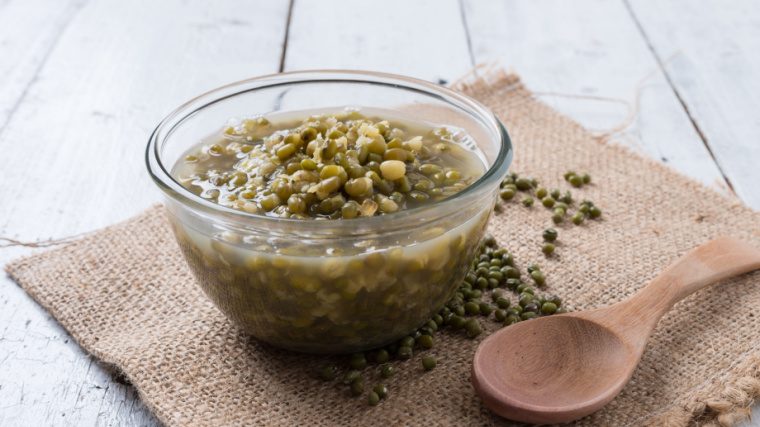 Credit: Regreto / Shutterstock
Credit: Regreto / Shutterstock
A one-cup serving of mung beans has 14.2 grams of protein, 0.8 grams of fat, and 38.8 grams of carbs.
Lima Beans
Lima beans are next on our list — another nutrient-dense legume that is a good vegan protein source. They’re also high in magnesium and potassium. You can get creative with recipes by combining multiple beans for a stir-fry or stew.
One cup of lima beans packs 11.6 grams of protein, 0.5 grams of fat, and 40 grams of carbs.
Green Peas
Forget about green peas as a boring side dish when you were a kid, and add them to your muscle-building veggie list. Green peas are also a great source of vitamin A and vitamin K.
A one-cup serving of green peas contains 8.58 grams of protein, 0.4 grams of fat, and 25 grams of carbs.
Quinoa
Quinoa is a whole grain that’s also a protein source. It’s an excellent base for a stir-fry, and you can add other high-protein vegetables. Quinoa is nutrient-dense. It contains antioxidants, folate, zinc, and fiber.
One cup of cooked quinoa has 8.1 grams of protein, 3.5 grams of fat, and 39.4 grams of carbs.
Wild Rice
Surprisingly, wild rice is not rice, but it makes a great addition to boost the protein content of a rice-based dish. Wild rice is a grain that contains potassium, iron, and plant-based protein.
A one-cup serving of wild rice contains 6.54 grams of protein, 0.5 grams of fat, and 34.9 carbs.
Sweet Corn
Sweet corn is a delicious summertime high-protein vegetable loaded with antioxidants.
One cup of sweet corn contains 5.4 grams of protein, 2.1 grams of fat, and 41 grams of carbs.
Cooked Spinach
As we move into the leafy green portion of the list, the protein content gets a little lower. However, leafy green vegetables like spinach are high in other micronutrients. Add them to your dishes that contain higher protein sources. Spinach contains vitamin A, iron, and fiber.
One cup of cooked spinach yields 5.35 grams of protein, 0.5 grams of fat, and 6.8 grams of carbs.
Artichokes
Artichokes are rich in micronutrients like vitamin C, folate, magnesium, potassium, and phosphorus. They also contain fiber and other antioxidants.
A one-cup serving of artichokes packs 5.0 grams of protein, 0.6 grams of fat, and 20 grams of carbs.
Collard Greens
Collard greens are rich in multiple vitamins and minerals. They’re a great source of calcium, folate, vitamin A, vitamin C, and vitamin K. They also contain fiber and antioxidants.
One cup of collard greens contains 4.21 grams of protein, 0.8 grams of fat, and 7.5 grams of carbs.
Brussels Sprouts
Brussels sprouts contain vitamin C and vitamin K. They’re a great addition to a dish with other high-protein vegetables.
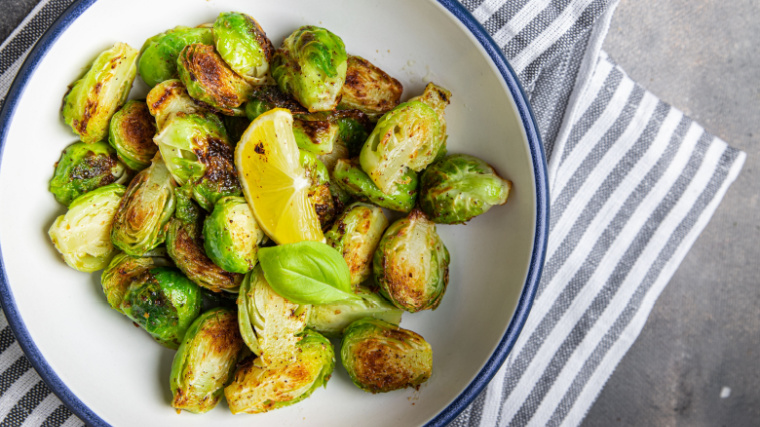 Credit: Alesia.Bierliezova / Shutterstock
Credit: Alesia.Bierliezova / Shutterstock
One cup of Brussels sprouts contains 4.0 grams of protein, 0.8 grams of fat, and 11 grams of carbs.
Sweet Potato
Sweet potatoes are a great source of healthy carbs and energy; some people like to have them as part of a pre-workout meal. They also make a great addition to a stir-fry or stew with other high-protein vegetables. Sweet potatoes contain vitamin A and vitamin C. They’re a great source of beta-carotene, a health-boosting antioxidant.
[Read More: What’s the Best Time to Drink Your Pre-Workout Mix?]
A one-cup serving of sweet potato yields 4.0 grams of protein, 0.3 grams of fat, and 41 grams of carbs.
How Much Protein Do You Need Daily?
Now that you know how much protein you can get from veggies, how much do you need daily?
As a minimum requirement for bodily functions, the Food and Drug Administration (FDA) recommends 50 grams of protein per day for adults. (13)
However, active people need more than 50 grams. The amount of protein you need may vary based on your body, age, activity level, and fitness goals.
Check out BarBend’s protein intake calculator to input your stats and get personalized protein needs.
Protein Intake Calculator
Imperial
Metric
Age
Sex
Male
Female
Height
Feet
Meters
Weight
Pounds
Kilograms
Goal
Fat Loss
Maintenance
Muscle Gains
Activity Level
Sedentary: little or no exercise
Exercise 1-3 times/week
Exercise 4-5 times/week
Daily exercise or intense exercise 3-4 times/week
Intense exercise 6-7 times/week
Very intense exercise daily, or physical job
Do you know your body fat percentage?
No
Yes
Calculate
Total Calories: 1699 Per Day
Daily protein intake recommendation:
Recommended
Protein
Minimum
(g)
Generally recommended
(g)
High
(g)
Exercise: 15-30 minutes of elevated heart rate activity.
Intense exercise: 45-120 minutes of elevated heart rate activity.
Very intense exercise: 2+ hours of elevated heart rate activity.
jQuery(document).ready(function($) {
$('.protein_in__calculator #eq').on('change', function() {
var bfat= $(this).find(":selected").val();
if (bfat == "3") {
$('.protein_in__calculator #katch').show();
}else{
$('.protein_in__calculator #katch').hide();
}
});
var units_x;
units_x="EN";
$('.protein_in__calculator input[name="units"]').click(function() {
var units_v = $(this).val();
if (units_v == "SI") {
$('.protein_in__calculator input[name="height-tens"]').attr("placeholder", "Meters");
$('.protein_in__calculator input[name="height-units"]').attr("placeholder", "Centimeters");
$('.protein_in__calculator input[name="weight"]').attr("placeholder", "Kilograms");
$('.protein_in__calculator input[name="height-tens"]').val("");
$('.protein_in__calculator input[name="height-units"]').val("");
$('.protein_in__calculator input[name="weight"]').val("");
units_x="SI";
$("input[id=macros-kilos]").prop("checked",true);
$("input[id=macros-pounds]").prop("checked",false);
}
else if (units_v == "EN") {
$('.protein_in__calculator input[name="height-tens"]').attr("placeholder", "Feet");
$('.protein_in__calculator input[name="height-units"]').attr("placeholder", "Inches");
$('.protein_in__calculator input[name="weight"]').attr("placeholder", "Pounds");
$('.protein_in__calculator input[name="height-tens"]').val("");
$('.protein_in__calculator input[name="height-units"]').val("");
$('.protein_in__calculator input[name="weight"]').val("");
units_x="EN";
$("input[id=macros-kilos]").prop("checked",false);
$("input[id=macros-pounds]").prop("checked",true);
}
});
//alert(units_x);
$('.protein_in__calculator input[name="height-system"]').click(function() {
var heightUnits = $(this).val();
if (heightUnits == "meters") {
$('.protein_in__calculator input[name="height-tens"]').attr("placeholder", "Meters");
$('.protein_in__calculator input[name="height-units"]').attr("placeholder", "Centimeters");
$('.protein_in__calculator input[name="height-tens"]').val("");
$('.protein_in__calculator input[name="height-units"]').val("");
}
else if (heightUnits == "feet") {
$('.protein_in__calculator input[name="height-tens"]').attr("placeholder", "Feet");
$('.protein_in__calculator input[name="height-units"]').attr("placeholder", "Inches");
$('.protein_in__calculator input[name="height-tens"]').val("");
$('.protein_in__calculator input[name="height-units"]').val("");
}
});
$('.protein_in__calculator input[name="weight-system"]').click(function() {
var weightUnits = $(this).val();
if (weightUnits == "kilos") {
$('.protein_in__calculator input[name="weight"]').attr("placeholder", "Kilograms");
$('.protein_in__calculator input[name="weight"]').val("");
}
else if (weightUnits == "pounds") {
$('.protein_in__calculator input[name="weight"]').attr("placeholder", "Pounds");
$('.protein_in__calculator input[name="weight"]').val("");
}
});
$('.protein_in__calculator .calc-submit').click(function() {
var height = 0;
var pbmr =0;
var pweight=0;
var katch = $("input[name='katch']").val();
if(katch==""){katch=20;}
katch = katch/100;
var eq = $('.protein_in__calculator #eq option:selected').val();
var heightTens = parseInt($('.protein_in__calculator input[name="height-tens"]').val());
var heightUnits= parseInt($('.protein_in__calculator input[name="height-units"]').val());
var heightType = $('.protein_in__calculator input[name="height-system"]:checked').val();
var weight = parseInt($('.protein_in__calculator input[name="weight"]').val());
var weightType = $('.protein_in__calculator input[name="weight-system"]:checked').val();
var calories = 0;
var age = parseInt($('.protein_in__calculator input[name=age]').val());
var sex = $('.protein_in__calculator input[name=sex]:checked').val();
var job = $('.protein_in__calculator input[name=activity]:checked').val();
var goal = $('.protein_in__calculator input[name=goal]:checked').val();
var protons = 0;
if (isNaN(age) || isNaN(heightTens) || isNaN(weight)) {
$('.protein_in__calculator .calc-answer').show(0).html('Please enter values for all the fields.').addClass('bb_cal_error').one('webkitAnimationEnd mozAnimationEnd MSAnimationEnd oanimationend animationend', function() {
$(this).removeClass('bb_cal_error');
});
$('html, body').animate({scrollTop: $(".calc-header").offset().top-150}, 1000);
$('.protein_in__calculator #cal_result').hide();
}
else {
if(isNaN(heightUnits)) {
heightUnits = 0;
}
//alert('heightType:'+units_x);
if (units_x == "EN") {
height = ((heightTens * 30.48) + (heightUnits * 2.54));
}
else {
height = (heightTens * 100) + heightUnits;
}
if (units_x == "EN") {
pweight = weight;
weight = (weight * 0.453592);
}else{
pweight = weight*2.205;
}
if (sex == "M") {
if (eq == "2"){
calories = ((weight * 10) + (height * 6.25) - (age * 5) + 5);
pbmr = Math.round(calories);
}else if (eq == "3"){
calories = Math.round(370+21.6*(1-katch)*weight);
pbmr = Math.round(calories);
}
}
else {
if (eq == "2"){
calories = ((weight * 10) + (height * 6.25) - (age * 5) - 161);
pbmr = Math.round(calories);
}else if (eq == "3"){
calories = Math.round(370+21.6*(1-katch)*weight);
pbmr = Math.round(calories);
}
}
switch (job) {
case "a1":
calories = Math.round(calories * 1.2);
break;
case "a2":
calories = Math.round(calories * 1.375);
break;
case "a3":
calories = Math.round(calories * 1.466);
break;
case "a4":
calories = Math.round(calories * 1.55);
break;
case "a5":
calories = Math.round(calories * 1.725);
break;
case "a6":
calories = Math.round(calories * 1.9);
break;
}
switch (goal) {
case "fat-loss":
if (calories 2000) calories = Math.round(0.8 * calories);
protons = Math.round(0.40 * calories / 4);
break;
case "maintenance":
protons = Math.round(0.30 * calories / 4);
break;
case "gains":
calories += 500;
protons = Math.round(0.30 * calories / 4);
break;
}
$('.protein_in__calculator #cal_result').show();
// alert(pweight);
//var phighr = Math.round(pweight*2.3)+' - '+Math.round(pweight*3.1)
var phighr = Math.round(pweight*1.5)
$('.protein_in__calculator .protein_in__min').html(Math.round(pweight*0.72));
$('.protein_in__calculator .protein_in__rec').html(Math.round(pweight*1));
$('.protein_in__calculator .protein_in__fat').html(phighr);
$('.protein_in__calculator .protein_in__result').html(calories);
$('html, body').animate({scrollTop: $(".protein_in__calculator #cal_result").offset().top-150}, 1000);
$('.protein_in__calculator .calc-answer').html('');
}
});
});
#bb_cal_ui .calc-header {
border-bottom: 2px solid #8cc540;
padding: 5px 0 !important;
font-size: 36px;
font-weight: 700;
margin: 34px 0 30px 0px !important;
}
#cal_result .bmrtable, #cal_result .bmrtable td, #cal_result .bmrtable tr, #cal_result .bmrtable th{
border: 0px;
padding: 8px 2px;
}
#cal_result .bmrtable td{
border-bottom: 1px solid #ccc;
}
#cal_result .bmrtable th{
border-bottom: 2px solid #92c663;
}
.protein_in__result_align{text-align:center; font-weight:600;}
#bb_cal_ui {
box-shadow: 0px 0px 10px 0px rgba(0,0,0,0.09);
transition: background 0.3s, border 0.3s, border-radius 0.3s, box-shadow 0.3s;
margin: 0px;
padding: 18px 20px 20px 20px;
}
.calc-label span{display:none!important;}
div#bb_cal_ui .hidenow{
display:none;
}
div#bb_cal_ui .cals-and-protein_in__calculator h2.calc-header {
background: #232323;
border: solid 1px #232323;
border-bottom: none;
border-radius: 3px 0px;
color: #ffffff !important;
margin: 0 !important;
padding: 15px;
}
.cals-and-protein_in__calculator .calc-container {
border: solid 1px #cccccc;
border-top: solid 1px #ffffff;
border-radius: 0 3px;
padding: 10px;
}
.cals-and-protein_in__calculator .calc-subheader {
display: block;
font-family: ProximaNovaExCnSemiBold;
font-size: 20px;
font-size: 2rem;
margin-top: 10px;
text-transform: uppercase;
}
.cals-and-protein_in__calculator .calc-row {
margin-bottom: 5px;
}
div#bb_cal_ui .cals-and-protein_in__calculator input.calc-textbox {
box-sizing: border-box;
height: auto;
line-height: inherit;
padding: 12px;
width: 100%;
}
div#bb_cal_ui .cals-and-protein_in__calculator input.calc-textbox-half {
box-sizing: border-box;
height: auto;
line-height: inherit;
padding: 12px;
width: 49.5%;
}
div#bb_cal_ui input.calc-textbox-halfd, div#bb_cal_ui select.calc-textbox-halfd {
box-sizing: border-box;
height: auto;
line-height: inherit;
padding: 4px 15px;
width: 48.5%!important;
font-weight: 500;
background: #fff;
color: #000;
font-size: 17px;
}
@media (max-width: 768px) {
div#bb_cal_ui input.calc-textbox-halfd, div#bb_cal_ui select.calc-textbox-halfd {
width: 100% !important;
}
.protein_in__calculator{margin:0px !important;}
#bb_cal_ui h3 {font-size: 20px;}
#bb_cal_ui .calc-header {
padding: 5px 0 !important;
font-size: 22px;
margin: 10px 0 25px 0px !important;
}
}
.cals-and-protein_in__calculator .calc-float-right {
float: right;
}
.cals-and-protein_in__calculator .calc-row input[type=radio] {
display: none;
}
.cals-and-protein_in__calculator .calc-row input[type=radio] + label span {
background: url('/images/bgsprite.png') no-repeat -75px -1250px;
cursor: pointer;
display: inline-block;
height: 23px;
margin: 2px 5px 5px 6px;
vertical-align: middle;
width: 21px;
}
.cals-and-protein_in__calculator .calc-row input[type=radio]:checked + label span {
background: url('/images/bgsprite.png') no-repeat -50px -1250px;
}
.cals-and-protein_in__calculator .calc-row input[type=radio]:checked + label {
background-color: #f4f4f4;
}
.cals-and-protein_in__calculator .calc-label {
border: solid 1px #5a5a5a;
border-radius: 3px;
cursor: pointer;
display: inline-block;
font-size: 14px;
font-size: 1.4rem;
font-weight: bold;
padding: 6px;
width: 100%;
}
.cals-and-protein_in__calculator .calc-label-small {
border: solid 1px #5a5a5a;
border-radius: 3px;
cursor: pointer;
display: inline-block;
font-size: 14px;
font-size: 1.4rem;
font-weight: bold;
padding: 6px;
width: 49.5%;
}
.cals-and-protein_in__calculator .calc-label:hover {
background-color: #f4f4f4;
}
.cals-and-protein_in__calculator .calc-answer {
display: none;
}
#bb_cal_ui h3:after {
content: "";
display: block;
width: 100px;
padding: 0px 0;
border-bottom: 0px solid #8cc540;
}
#bb_cal_ui .calc-container{
padding:0px;
}
#bb_cal_ui .g-heading {
display: -webkit-box;
display: -webkit-flex;
display: -ms-flexbox;
display: flex;
margin-bottom: 0;
padding: 0;
-webkit-box-pack: justify;
-webkit-justify-content: space-between;
-ms-flex-pack: justify;
justify-content: space-between;
...
Click here to view the article.
The post Add These High-Protein Vegetables to Your Diet for a Muscle-Building Boost appeared first on BarBend.
As a regular gymgoer, you probably know that protein is your best friend. Building muscle, recovering from hard training, and losing body fat require a pretty high protein intake. You may understandably assume that you have to eat plenty of meat and chicken to get there. But did you know you can get protein from vegetables, as well?
High-protein vegetables are packed with health-boosting nutrients, and you can combine them into satisfying, tasty meals to help you reach your goals. Whether you want to build muscle on a vegan diet or just add more plant-based protein, we’ve got the goods.

Here, you’ll learn explain the health benefits of protein and the most protein-rich veggies with all their nutritional information. We’ll also give you the details on calculating how much protein your body needs, depending on your goals. Healthy eating doesn’t have to be bland. So grab your shopping list and prepare to add these muscle-building veggies to your meal plan.
Editor’s Note: The content on BarBend is meant to be informative in nature, but it should not be taken as medical advice. When starting a new training regimen and/or diet, it is always a good idea to consult with a trusted medical professional. We are not a medical resource. The opinions and articles on this site are not intended for use as diagnosis, prevention, and/or treatment of health problems. They are not substitutes for consulting a qualified medical professional.
- Why You Need Protein
- Can You Get Adequate Protein From Vegetables?
- The Best High-Protein Vegetables
- How Much Protein Do You Need Daily?
- Frequently Asked Questions
Why You Need Protein
All your food consists of three macronutrients: protein, carbohydrates, and fat. Macronutrients combine to influence your health and provide energy. (1)
You need all three to fuel your health and workouts, but we’re here for muscle hypertrophy. When it comes to training, you need protein to help you build muscle mass and lose body fat. Eating a healthy diet packed with protein also influences your heart and bone health while boosting your immune system. Let’s break it down.
Helps Build Muscle Mass
Strength athletes are so fond of protein for a reason. This macronutrient helps build muscle mass when paired with resistance training. Here’s how it works.
Twenty amino acids, often called building blocks, make up muscle protein. Eleven amino acids are non-essential, and the remaining nine are essential amino acids. Your body cannot make them on its own, so you need to get them through your diet as complete protein sources. All twenty amino acids are necessary for hypertrophy. (2)

[Read More: The 12 Best Vegan Protein Powders]
When you’re in the gym lifting weights, you’re breaking down your muscle fibers. When you eat high-protein foods, you’re consuming dietary protein that helps repair and regenerate your muscle fibers after all those intense leg exercises on your favorite training day of the week. This process leads to muscle protein synthesis — or building muscle mass. (3)(4)
Resistance training is half of the equation, but your body needs protein to maximize your hard-earned gains.
Helps With Fat Loss
Whether you have a weight loss goal or you’re a bodybuilder on a weight cut, protein will help you with fat loss. Feeling full from your food can help you stay on track when you’re reducing your calories or portions. Protein is the most satiating macronutrient, so packing your meals with it can help you feel full between meals. (5)
Eating a high-protein diet also increases thermogenesis, meaning your body has to work harder to digest your food, slightly increasing your total daily energy expenditure (TDEE). Complete protein sources may have a higher thermic effect, increasing your TDEE even more. (5)(6)
[Read More: 20 High-Fiber Foods to Support Digestion]
Lastly, a high-protein diet and resistance training during weight loss can help your body preserve lean muscle mass. Some people can theoretically lose weight by reducing their calories or portions, but they may also lose muscle. Keeping your protein high and lifting weights is the key to maintaining muscle mass while losing body fat. (5)
Improves Heart Health
Athletes need a strong heart for tough HIIT workouts — AKA, high-intensity interval training sessions. Healthy eating and regular exercise are fundamental to strong cardiovascular health. Getting enough protein can help lower your risk of high blood pressure, high cholesterol, and heart disease. (7)
The sources of protein you choose matter, too. A 2020 meta-analysis examined the link between different types of protein and cardiovascular (CV) diseases. They found that plant-based protein may be associated with a lower risk of CV diseases. (8)

[Read More: The 13 Best Protein Powder]
It doesn’t mean you have to give up all meat — but it’s all the more reason to add some of our high-protein vegetables to your diet.
Boosts Bone Health
What else does an athlete need beyond solid muscles and a healthy heart? Strong bones.
You may think of vitamin D and calcium as the nutrients associated with bone health, but protein is also essential. Research shows that protein enhances IGF-1, a growth hormone that influences bone development. In multiple clinical trials, low protein intake has been associated with low bone health. (9)
[Read More: 20 High-Protein, Low-Calorie Foods Worth Subbing Into Your Diet]
Consuming enough protein can also help prevent osteoporosis, a condition where you lose bone mass as you age. Older adults, especially cisgender women, are more likely to develop it. Osteoporosis can also increase your risk of fractures. (9)
Health professionals recommend getting plenty of protein, vitamin D, and calcium in your diet, along with resistance training and weight-bearing cardio workouts, to prevent osteoporosis.
Boosts Immune System
It has been well-established that eating a diet low in protein can weaken your immune system. The amino acids in protein directly impact your immune system — particularly arginine, glutamine, and cysteine. (10)
Consuming complete protein sources will give you all the amino acids your body needs to fight off illnesses. Eating protein-rich vegetables will also give you micronutrients and antioxidants, which can help strengthen your immune cells. (11)
Can You Get Adequate Protein From Vegetables?
Yes, you can reach your protein intake goals through high-protein vegetables alone. Plenty of vegetarian and vegan athletes build muscle through plant-based protein. Whether you’re looking to stop eating animal products or just want to add more plants to your diet, you’ll just need to make some adjustments.
Sure, getting 30 grams of protein through a single serving of chicken breast may be quicker than countless servings of spinach, but you can get creative. Combining multiple high-protein vegetables into stews or a stir-fry can increase the protein content of your plant-based dish.

[Read More: The 12 Best Greens Powders]
Dietitians recommend getting the bulk of your nutrients through food sources, but you can add supplements if you struggle to get enough protein. Making shakes with a high-quality vegan protein powder can help you boost your intake. Soy protein powder is a great choice. It’s a complete protein source and contains all the essential amino acids you need to build muscle.
The Best High-Protein Vegetables
You may be used to having veggies as a side dish or salad, but they can also be the main event. Here are the best high-protein vegetables to boost your nutrient intake or support a vegan diet.
The nutritional information for these veggies comes from the FoodData Central feature on the United States Department of Agriculture (USDA) website. (12)
- Edamame
- Lentils
- Black Beans
- Chickpeas
- Mung Beans
- Lima Beans
- Green Peas
- Quinoa
- Wild Rice
- Sweet Corn
- Cooked Spinach
- Artichokes
- Collard Greens
- Brussels Sprouts
- Sweet Potato
Edamame
Edamame beans are a type of soybean from the legumes family. Edamame is one of the most protein-rich vegetables you can eat. They also contain vitamin K and folate and are a great source of healthy carbs.
One cup of edamame contains 18.5 grams of protein, 12 grams of fat, and 13.8 grams of carbohydrates.
Lentils
Lentils are also from the legume family. Some consider them a superfood because they are so nutrient-dense. They contain B vitamins, magnesium, potassium, and phosphorus. They’re a great source of protein and also high in fiber.
One cup of lentils yields 17.9 grams of protein, 0.8 grams of fat, and 39.9 grams of carbs.
Black Beans
Black beans are versatile and a great addition to a stir-fry. They contain antioxidants to boost your immune system and fiber to keep you full.
A one-cup serving of black beans has 15 grams of protein, one gram of fat, and 41 grams of carbs.
Chickpeas
Chickpeas, or garbanzo beans, are a nutty legume and the main ingredient in hummus and falafel. Chickpeas contain fiber, protein, B vitamins, and folate.
One cup of chickpeas yields 14.5 grams of protein, four grams of fat, and 45 grams of carbs.
Mung Beans
Mung beans are another superfood to add to your diet. They’re high in all of the essential amino acids that you need to build muscle. Mung beans also contain potassium, magnesium, phosphorus, and other antioxidants that may help lower blood pressure and cholesterol.

A one-cup serving of mung beans has 14.2 grams of protein, 0.8 grams of fat, and 38.8 grams of carbs.
Lima Beans
Lima beans are next on our list — another nutrient-dense legume that is a good vegan protein source. They’re also high in magnesium and potassium. You can get creative with recipes by combining multiple beans for a stir-fry or stew.
One cup of lima beans packs 11.6 grams of protein, 0.5 grams of fat, and 40 grams of carbs.
Green Peas
Forget about green peas as a boring side dish when you were a kid, and add them to your muscle-building veggie list. Green peas are also a great source of vitamin A and vitamin K.
A one-cup serving of green peas contains 8.58 grams of protein, 0.4 grams of fat, and 25 grams of carbs.
Quinoa
Quinoa is a whole grain that’s also a protein source. It’s an excellent base for a stir-fry, and you can add other high-protein vegetables. Quinoa is nutrient-dense. It contains antioxidants, folate, zinc, and fiber.
One cup of cooked quinoa has 8.1 grams of protein, 3.5 grams of fat, and 39.4 grams of carbs.
Wild Rice
Surprisingly, wild rice is not rice, but it makes a great addition to boost the protein content of a rice-based dish. Wild rice is a grain that contains potassium, iron, and plant-based protein.
A one-cup serving of wild rice contains 6.54 grams of protein, 0.5 grams of fat, and 34.9 carbs.
Sweet Corn
Sweet corn is a delicious summertime high-protein vegetable loaded with antioxidants.
One cup of sweet corn contains 5.4 grams of protein, 2.1 grams of fat, and 41 grams of carbs.
Cooked Spinach
As we move into the leafy green portion of the list, the protein content gets a little lower. However, leafy green vegetables like spinach are high in other micronutrients. Add them to your dishes that contain higher protein sources. Spinach contains vitamin A, iron, and fiber.
One cup of cooked spinach yields 5.35 grams of protein, 0.5 grams of fat, and 6.8 grams of carbs.
Artichokes
Artichokes are rich in micronutrients like vitamin C, folate, magnesium, potassium, and phosphorus. They also contain fiber and other antioxidants.
A one-cup serving of artichokes packs 5.0 grams of protein, 0.6 grams of fat, and 20 grams of carbs.
Collard Greens
Collard greens are rich in multiple vitamins and minerals. They’re a great source of calcium, folate, vitamin A, vitamin C, and vitamin K. They also contain fiber and antioxidants.
One cup of collard greens contains 4.21 grams of protein, 0.8 grams of fat, and 7.5 grams of carbs.
Brussels Sprouts
Brussels sprouts contain vitamin C and vitamin K. They’re a great addition to a dish with other high-protein vegetables.

One cup of Brussels sprouts contains 4.0 grams of protein, 0.8 grams of fat, and 11 grams of carbs.
Sweet Potato
Sweet potatoes are a great source of healthy carbs and energy; some people like to have them as part of a pre-workout meal. They also make a great addition to a stir-fry or stew with other high-protein vegetables. Sweet potatoes contain vitamin A and vitamin C. They’re a great source of beta-carotene, a health-boosting antioxidant.
[Read More: What’s the Best Time to Drink Your Pre-Workout Mix?]
A one-cup serving of sweet potato yields 4.0 grams of protein, 0.3 grams of fat, and 41 grams of carbs.
How Much Protein Do You Need Daily?
Now that you know how much protein you can get from veggies, how much do you need daily?
As a minimum requirement for bodily functions, the Food and Drug Administration (FDA) recommends 50 grams of protein per day for adults. (13)
However, active people need more than 50 grams. The amount of protein you need may vary based on your body, age, activity level, and fitness goals.
Check out BarBend’s protein intake calculator to input your stats and get personalized protein needs.
Protein Intake Calculator
Imperial
Metric
Age
Sex
Male
Female
Height
Feet
Meters
Weight
Pounds
Kilograms
Goal
Fat Loss
Maintenance
Muscle Gains
Activity Level
Sedentary: little or no exercise
Exercise 1-3 times/week
Exercise 4-5 times/week
Daily exercise or intense exercise 3-4 times/week
Intense exercise 6-7 times/week
Very intense exercise daily, or physical job
Do you know your body fat percentage?
No
Yes
Calculate
Total Calories: 1699 Per Day
Daily protein intake recommendation:
Recommended
Protein
Minimum
(g)
Generally recommended
(g)
High
(g)
Exercise: 15-30 minutes of elevated heart rate activity.
Intense exercise: 45-120 minutes of elevated heart rate activity.
Very intense exercise: 2+ hours of elevated heart rate activity.
jQuery(document).ready(function($) {
$('.protein_in__calculator #eq').on('change', function() {
var bfat= $(this).find(":selected").val();
if (bfat == "3") {
$('.protein_in__calculator #katch').show();
}else{
$('.protein_in__calculator #katch').hide();
}
});
var units_x;
units_x="EN";
$('.protein_in__calculator input[name="units"]').click(function() {
var units_v = $(this).val();
if (units_v == "SI") {
$('.protein_in__calculator input[name="height-tens"]').attr("placeholder", "Meters");
$('.protein_in__calculator input[name="height-units"]').attr("placeholder", "Centimeters");
$('.protein_in__calculator input[name="weight"]').attr("placeholder", "Kilograms");
$('.protein_in__calculator input[name="height-tens"]').val("");
$('.protein_in__calculator input[name="height-units"]').val("");
$('.protein_in__calculator input[name="weight"]').val("");
units_x="SI";
$("input[id=macros-kilos]").prop("checked",true);
$("input[id=macros-pounds]").prop("checked",false);
}
else if (units_v == "EN") {
$('.protein_in__calculator input[name="height-tens"]').attr("placeholder", "Feet");
$('.protein_in__calculator input[name="height-units"]').attr("placeholder", "Inches");
$('.protein_in__calculator input[name="weight"]').attr("placeholder", "Pounds");
$('.protein_in__calculator input[name="height-tens"]').val("");
$('.protein_in__calculator input[name="height-units"]').val("");
$('.protein_in__calculator input[name="weight"]').val("");
units_x="EN";
$("input[id=macros-kilos]").prop("checked",false);
$("input[id=macros-pounds]").prop("checked",true);
}
});
//alert(units_x);
$('.protein_in__calculator input[name="height-system"]').click(function() {
var heightUnits = $(this).val();
if (heightUnits == "meters") {
$('.protein_in__calculator input[name="height-tens"]').attr("placeholder", "Meters");
$('.protein_in__calculator input[name="height-units"]').attr("placeholder", "Centimeters");
$('.protein_in__calculator input[name="height-tens"]').val("");
$('.protein_in__calculator input[name="height-units"]').val("");
}
else if (heightUnits == "feet") {
$('.protein_in__calculator input[name="height-tens"]').attr("placeholder", "Feet");
$('.protein_in__calculator input[name="height-units"]').attr("placeholder", "Inches");
$('.protein_in__calculator input[name="height-tens"]').val("");
$('.protein_in__calculator input[name="height-units"]').val("");
}
});
$('.protein_in__calculator input[name="weight-system"]').click(function() {
var weightUnits = $(this).val();
if (weightUnits == "kilos") {
$('.protein_in__calculator input[name="weight"]').attr("placeholder", "Kilograms");
$('.protein_in__calculator input[name="weight"]').val("");
}
else if (weightUnits == "pounds") {
$('.protein_in__calculator input[name="weight"]').attr("placeholder", "Pounds");
$('.protein_in__calculator input[name="weight"]').val("");
}
});
$('.protein_in__calculator .calc-submit').click(function() {
var height = 0;
var pbmr =0;
var pweight=0;
var katch = $("input[name='katch']").val();
if(katch==""){katch=20;}
katch = katch/100;
var eq = $('.protein_in__calculator #eq option:selected').val();
var heightTens = parseInt($('.protein_in__calculator input[name="height-tens"]').val());
var heightUnits= parseInt($('.protein_in__calculator input[name="height-units"]').val());
var heightType = $('.protein_in__calculator input[name="height-system"]:checked').val();
var weight = parseInt($('.protein_in__calculator input[name="weight"]').val());
var weightType = $('.protein_in__calculator input[name="weight-system"]:checked').val();
var calories = 0;
var age = parseInt($('.protein_in__calculator input[name=age]').val());
var sex = $('.protein_in__calculator input[name=sex]:checked').val();
var job = $('.protein_in__calculator input[name=activity]:checked').val();
var goal = $('.protein_in__calculator input[name=goal]:checked').val();
var protons = 0;
if (isNaN(age) || isNaN(heightTens) || isNaN(weight)) {
$('.protein_in__calculator .calc-answer').show(0).html('Please enter values for all the fields.').addClass('bb_cal_error').one('webkitAnimationEnd mozAnimationEnd MSAnimationEnd oanimationend animationend', function() {
$(this).removeClass('bb_cal_error');
});
$('html, body').animate({scrollTop: $(".calc-header").offset().top-150}, 1000);
$('.protein_in__calculator #cal_result').hide();
}
else {
if(isNaN(heightUnits)) {
heightUnits = 0;
}
//alert('heightType:'+units_x);
if (units_x == "EN") {
height = ((heightTens * 30.48) + (heightUnits * 2.54));
}
else {
height = (heightTens * 100) + heightUnits;
}
if (units_x == "EN") {
pweight = weight;
weight = (weight * 0.453592);
}else{
pweight = weight*2.205;
}
if (sex == "M") {
if (eq == "2"){
calories = ((weight * 10) + (height * 6.25) - (age * 5) + 5);
pbmr = Math.round(calories);
}else if (eq == "3"){
calories = Math.round(370+21.6*(1-katch)*weight);
pbmr = Math.round(calories);
}
}
else {
if (eq == "2"){
calories = ((weight * 10) + (height * 6.25) - (age * 5) - 161);
pbmr = Math.round(calories);
}else if (eq == "3"){
calories = Math.round(370+21.6*(1-katch)*weight);
pbmr = Math.round(calories);
}
}
switch (job) {
case "a1":
calories = Math.round(calories * 1.2);
break;
case "a2":
calories = Math.round(calories * 1.375);
break;
case "a3":
calories = Math.round(calories * 1.466);
break;
case "a4":
calories = Math.round(calories * 1.55);
break;
case "a5":
calories = Math.round(calories * 1.725);
break;
case "a6":
calories = Math.round(calories * 1.9);
break;
}
switch (goal) {
case "fat-loss":
if (calories 2000) calories = Math.round(0.8 * calories);
protons = Math.round(0.40 * calories / 4);
break;
case "maintenance":
protons = Math.round(0.30 * calories / 4);
break;
case "gains":
calories += 500;
protons = Math.round(0.30 * calories / 4);
break;
}
$('.protein_in__calculator #cal_result').show();
// alert(pweight);
//var phighr = Math.round(pweight*2.3)+' - '+Math.round(pweight*3.1)
var phighr = Math.round(pweight*1.5)
$('.protein_in__calculator .protein_in__min').html(Math.round(pweight*0.72));
$('.protein_in__calculator .protein_in__rec').html(Math.round(pweight*1));
$('.protein_in__calculator .protein_in__fat').html(phighr);
$('.protein_in__calculator .protein_in__result').html(calories);
$('html, body').animate({scrollTop: $(".protein_in__calculator #cal_result").offset().top-150}, 1000);
$('.protein_in__calculator .calc-answer').html('');
}
});
});
#bb_cal_ui .calc-header {
border-bottom: 2px solid #8cc540;
padding: 5px 0 !important;
font-size: 36px;
font-weight: 700;
margin: 34px 0 30px 0px !important;
}
#cal_result .bmrtable, #cal_result .bmrtable td, #cal_result .bmrtable tr, #cal_result .bmrtable th{
border: 0px;
padding: 8px 2px;
}
#cal_result .bmrtable td{
border-bottom: 1px solid #ccc;
}
#cal_result .bmrtable th{
border-bottom: 2px solid #92c663;
}
.protein_in__result_align{text-align:center; font-weight:600;}
#bb_cal_ui {
box-shadow: 0px 0px 10px 0px rgba(0,0,0,0.09);
transition: background 0.3s, border 0.3s, border-radius 0.3s, box-shadow 0.3s;
margin: 0px;
padding: 18px 20px 20px 20px;
}
.calc-label span{display:none!important;}
div#bb_cal_ui .hidenow{
display:none;
}
div#bb_cal_ui .cals-and-protein_in__calculator h2.calc-header {
background: #232323;
border: solid 1px #232323;
border-bottom: none;
border-radius: 3px 0px;
color: #ffffff !important;
margin: 0 !important;
padding: 15px;
}
.cals-and-protein_in__calculator .calc-container {
border: solid 1px #cccccc;
border-top: solid 1px #ffffff;
border-radius: 0 3px;
padding: 10px;
}
.cals-and-protein_in__calculator .calc-subheader {
display: block;
font-family: ProximaNovaExCnSemiBold;
font-size: 20px;
font-size: 2rem;
margin-top: 10px;
text-transform: uppercase;
}
.cals-and-protein_in__calculator .calc-row {
margin-bottom: 5px;
}
div#bb_cal_ui .cals-and-protein_in__calculator input.calc-textbox {
box-sizing: border-box;
height: auto;
line-height: inherit;
padding: 12px;
width: 100%;
}
div#bb_cal_ui .cals-and-protein_in__calculator input.calc-textbox-half {
box-sizing: border-box;
height: auto;
line-height: inherit;
padding: 12px;
width: 49.5%;
}
div#bb_cal_ui input.calc-textbox-halfd, div#bb_cal_ui select.calc-textbox-halfd {
box-sizing: border-box;
height: auto;
line-height: inherit;
padding: 4px 15px;
width: 48.5%!important;
font-weight: 500;
background: #fff;
color: #000;
font-size: 17px;
}
@media (max-width: 768px) {
div#bb_cal_ui input.calc-textbox-halfd, div#bb_cal_ui select.calc-textbox-halfd {
width: 100% !important;
}
.protein_in__calculator{margin:0px !important;}
#bb_cal_ui h3 {font-size: 20px;}
#bb_cal_ui .calc-header {
padding: 5px 0 !important;
font-size: 22px;
margin: 10px 0 25px 0px !important;
}
}
.cals-and-protein_in__calculator .calc-float-right {
float: right;
}
.cals-and-protein_in__calculator .calc-row input[type=radio] {
display: none;
}
.cals-and-protein_in__calculator .calc-row input[type=radio] + label span {
background: url('/images/bgsprite.png') no-repeat -75px -1250px;
cursor: pointer;
display: inline-block;
height: 23px;
margin: 2px 5px 5px 6px;
vertical-align: middle;
width: 21px;
}
.cals-and-protein_in__calculator .calc-row input[type=radio]:checked + label span {
background: url('/images/bgsprite.png') no-repeat -50px -1250px;
}
.cals-and-protein_in__calculator .calc-row input[type=radio]:checked + label {
background-color: #f4f4f4;
}
.cals-and-protein_in__calculator .calc-label {
border: solid 1px #5a5a5a;
border-radius: 3px;
cursor: pointer;
display: inline-block;
font-size: 14px;
font-size: 1.4rem;
font-weight: bold;
padding: 6px;
width: 100%;
}
.cals-and-protein_in__calculator .calc-label-small {
border: solid 1px #5a5a5a;
border-radius: 3px;
cursor: pointer;
display: inline-block;
font-size: 14px;
font-size: 1.4rem;
font-weight: bold;
padding: 6px;
width: 49.5%;
}
.cals-and-protein_in__calculator .calc-label:hover {
background-color: #f4f4f4;
}
.cals-and-protein_in__calculator .calc-answer {
display: none;
}
#bb_cal_ui h3:after {
content: "";
display: block;
width: 100px;
padding: 0px 0;
border-bottom: 0px solid #8cc540;
}
#bb_cal_ui .calc-container{
padding:0px;
}
#bb_cal_ui .g-heading {
display: -webkit-box;
display: -webkit-flex;
display: -ms-flexbox;
display: flex;
margin-bottom: 0;
padding: 0;
-webkit-box-pack: justify;
-webkit-justify-content: space-between;
-ms-flex-pack: justify;
justify-content: space-between;
...
Click here to view the article.




